
Simple Wound Care Page Menu: 1 2 3 4 5 6 Next>>
Simple Wound Care in the Golden Age of Piracy, Page 1
Wound care was a significant part of a surgeon's work on a ship. Although sea surgeons were less familiar with the more theoretical role physicians played in diagnosing and treating problems such as fevers, venereal diseases and similar illnesses, they were well versed in the hands-on job of treating wounds.
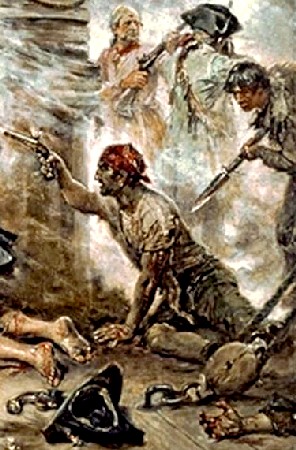
Artist: Jean Leon Gerome Ferris
Capture of the Pirate Blackbeard in 1718 (1920)
The word 'wound' encompasses a lot of things. In his 1706 dictionary, Edward Phillips defined a wound as "a bloudy rupture or solution [separation] of the natural Union of the soft Parts, by a pricking, cutting, or bruising Instrument: With respect to situation, Wounds may be termed Simple, Compound, Dangerous or Mortal."1
This article focuses on the treatment of simple wounds. To understand what such simple wounds were, it is helpful to understand what they weren't. After he defined wounds, Phillips went on to explain that Compound Wounds (or Complicated Wounds as he later refers to them) are "accompany'd with grievous Symptoms, as Fluxes [flows] of Bloud, breaking or disjoynting of Bones, Lameness &c."2 While simple bleeding wounds will be addressed in this article, compound wounds - those accompanied by fractures - are not, being covered in detail in the article on fractures.
Wounds caused by projectiles that entered the body such as bullets and large splinters generated by cannon fire also required a certain amount of specialized treatment and are also discussed in their own article.
What Phillips called 'mortal wounds' were "unavoidably... follow'd by Death, when it is situate deep in a principal Part, necessary for preservation of Life: Such are Wounds in the Heart, Lungs, Midriff, Liver, Spleen &c. and generally in all the great Vessels."3 Being complex and treated much differently during the golden age of piracy than standard wounds, wounds of the torso are also discussed in their own article. Similarly, specialized treatment of wounds of the skull are found in the head surgery and eye wound articles. Capital wounds of the limbs - those requiring amputation - are also handled in their own article since their cure relied on specific, complex procedures .
Having explained what will not be discussed in this article, let's talk about what will be discussed. The simple wounds which Phillips mentions in his definition are basically of two types: those where the skin has been broken - such as cuts and punctures - and those where the skin has been damaged but not broken - such as bruises. We begin with a look at descriptions of pirates wounded in such fashion at sea from the time. We then discuss the treatment of these wounds, examining the theories behind the treatment and the steps taken to prosecute the cure. We will first look at broken skin wounds and the five steps of treatment which include removal of foreign objects, bringing and keeping the wound lips together, humoral treatments designed to encourage healing by maintaining wound temperament and remedying complications. We will then discuss the less intricate treatment of bruises.
1,2,3 Edward Phillips, "Wound", The new world of words, 6th edition, 1706, not paginated;
Simple Wound Descriptions

Artist: Unknown, after Egbert van Heemskerck
Removing a Plaster From the Back of a Man's Hand. Wellcome Collection (17th c.)
When compared with other types of wounds, there are an unusually large number of references to simple wounds in the period sea literature. This should not be particularly surprising given that the environment, the jobs performed and the conditions of work all lent themselves to these types of wounds.
As a result, cuts and beatings which would likely cause bruising are found in a fairly large number of references during the golden age of piracy. What is not evident in these accounts is how such wounds were dealt with. This is probably due to the fact that the majority of information about pirates came from court and newspaper accounts where the focus was directed towards the crime committed rather than anything that resulted from that commission. Even the witness accounts give scant details on how wounds to the pirates and their victims were handled.
Let's review some of the accounts of pirates being wounded or inflicting wounds during the golden age of piracy, dividing them by general wounds, cuts, splinters and bruises.
Simple Wound Descriptions: General Wounds
Several pirate accounts mention the wounding of men during engagements without giving any detail on what sort of wounds those men incurred. This is due to the fact that most pirate accounts were not narratives, but were based on court accounts where such details were mentioned as a matter of record but not explored. Some of them were little more than footnotes to the action. For example, during the trial of William Kidd in 1701 for the attack on the Quadeh Merchant, former crewman and witness Robert Bradinham mentions that
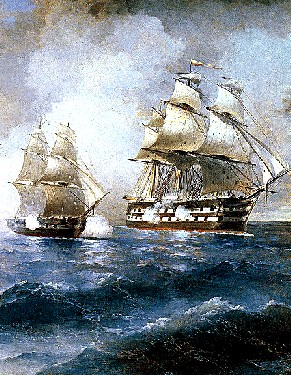
Artist: Ivan Aivazovsky
Brig Mercury Attacked by Turkish Ship (1892)
during the attack on a Portuguese man-of-war, "Capt. Kidd had ten Men wounded" and in the taking of a 'Moorish Ketch', "we had one Man wounded in taking of her."1 No further information is given about the men, their wounds or treatment.
Sometimes internecine battles resulted in wounds. Carpenter Thomas Fern of Captain John Phillips' crew was so incensed that a newly recruited pirate was made Quartermaster over the heads of the men who had been with Phillips before he came aboard that Fern decided to steal a Snow which they had just captured by way of retaliation. Phillips "perceiv'd their Design, and gave them Chace, who coming up with the Vessel, a Skirmish ensu'd, wherein Wood was kill'd and Taylor wounded in his Leg; upon which the other two surrender'd."2
Pirates were often wounded during the battle that preceded their being taken by agents of the government. Such wounds would have probably been dressed after the battle while they were awaiting indictment. Charles Johnson records that during the taking of Captain Richard Worley's pirate ship by two ships sent by the governor of North Carolina, the pirates "fought very obstinately, Hand to Hand, so that in a few Minutes, abundance of Men lay weltering in their Gore... [all] were all killed except the Captain and another Man, and those very much wounded, whom they reserved for the Gallows."3
Even if their wounds weren't always detailed, we know at least some men were healed after being taken; during the capture of Blackbeard's men, recent pirate recruit Samuel Odell "was a little unlucky at his first entering upon his new Trade, there appearing no less than 70 Wounds upon him after the Action, notwithstanding which, he lived, and was cured of them all."4
1 "The Arraignment, Tryal, and Comdemanation of Captain William Kidd",1702, From British Piracy in he Golden Age, Vol. 2, Joel Baer, ed., 2007, p. 167; 2 Captain Charles Johnson, A general history of the pirates, 3rd Edition, p. 400; 3 Johnson, p. 345-6; 3 Johnson, p. 345-6
Simple Wound Descriptions: Broken Skin
Cuts, punctures and similar broken skin wounds at sea are well supported in sailor and pirate accounts from this period, although minor cuts which would have been accidental or received while performing regular sailor's duties are not mentioned very often. One unusual account of a less severe cut comes from sailor Edward Barlow's Journal, who noted that while they were sailing in the North Sea where "many times we had cross winds with such a mist that we could not see one ship sometimes, and extreme cold, the mist freezing into ice, making the smallest rope in the ship as big as one's arm, and they (the ropes) so cold and slippery and sharp that they would cut our hands when hauling upon them."1
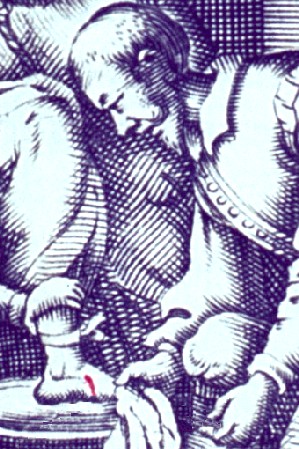
Artist: Cintio d'Amato
From Nuova et utlilssima prattica di tutto quello ch'al diligente
barbiero s'appartiene, Opposite p. 40 (1671)
However, such minor cuts, while probably frequent, are not typically found in the period sea literature. It is likely that these injuries were not reported or, like minor cuts today, would simply have been medicated and covered with plasters by the surgeon's mate during the daily dressing sessions. These were performed by the surgeon's mate (assistant). Sea surgeon John Moyle orders the surgeon's mate to
furnish your dressing Box (that is a box with six or eight partitions with Pots or Glasses of Oyles or Balsams, and Emplasters [plasters - the period equivalent to modern band-aids], ready spread for present occasion) which box you must every morning carry to the Mast between Decks, to dress such as have any hurts or ailments; and there with our [probably brass] Mortar we usually ring [by banging the pestle against the metal mortar], that such as have occasion may hear in any part of the Ship and come to be drest.2
The type of broken-skin wounds most often mentioned in period sailors and pirate accounts tended to be more severe, often being caused by bladed tools. Knives were the most common bladed instrument carried by a sailor and could be used both as a weapon and a tool, making them most useful and likely to be carried by sailors, who daily dealt with rigging ropes.3 Less often used, but still present on a ship were swords. Swords were not typically carried, but were kept in an armory and issued when needed, such as when the ship was attacking or being attacked.4
There are a variety of period accounts which mention cuts suffered during fights. Some of these were the result of disagreements between crew members on the ship. Military surgeon Richard Wiseman described an incident between one of his Dunkirk privateers and a Dutchman where
the Hollanders began to prate of Religion, upbraiding one of our men for wearing a Cross; and after a while, growing more heated with drink, he became quarrelsome, and swore Sacrament he would not wear a Cross, no, the Devil take him, repeating it often. One of our men beat him down, and fell with him; then kneeling upon his Breast, and holding his Head down, he drew out a Knife sticking in his Sash, & cut him from the Ear towards the Mouth, then from the Os zygoma [cheek bone] to the neather Jaw. Now, said he, you shall wear a Cross, that the Devil do not carry you away. I was sent for from the next house as a friend to that Religion...5
Another disagreement resulting in such a wound occurred when the
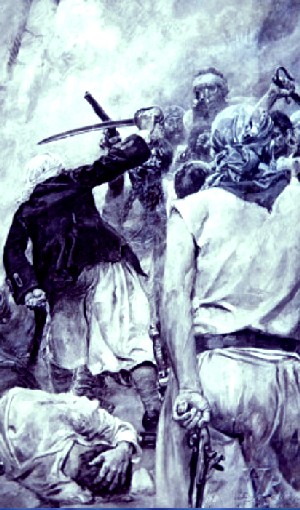
Artist: Howard Pyle
The Combatants Cut and Slashed With Savage Fury (1901)
Dutch took over the French settlements in New York harbor and forced the French boats transporting furs to give them their furs in 1674. "Captain [George] Manning had in his cabin a loaded pistol and planned to shoot Captain Roderigo but a boy on board warned him to look out for himself and drawing a cutlass the "Flanderkin " laid about him. ...Manning ...received a flesh wound in one hand and was cut about the head."6
Men were sometimes wounded by natives with arrows which would have created broken skin puncture wounds, although this appears to have been rare during this period. In 1669, Captain John Wood reported that while he was at Tierra de Fuego, the Patagonians wounded Thomas Cavindish, another man and a boy with arrows.7 Pirates and sailors typically did not use arrows or crossbows during this time.
Other cuts occurred during attacks. William Dampier said that when Malaysian natives thought the crew on his ship were after their boat, they "drew out their Cressets [kreeses, long daggers], and stabbed five or six of our before they knew what the matter was. The rest of the Men leapt over-board, some into the Canao, and some into the Sea, and got away."8 Such behaviors were not limited to natives; when pirate captain Ned Low attacked a sloop commanded by James Cahoon, Cahoon "was badly cut in the arm during the scrimmage"9 by one of the pirates.
Pirates often used force to get what they wanted. Such force included cutting men. As Captain Johnson explains in his account of Bartholomew Roberts, "The Captain's Power is uncontroulable in Chace, or in Battle, drubbing, cutting, or even shooting any one who dares deny his Command. The same Privilege he takes over Prisoners, who receive good or ill Usage, mostly as he approves of their Behaviour"10. This behavior was sometimes employed by the other pirates who wanted to learn the location of hidden treasure on a prize ship, convince new recruits to sign the articles or just to punish people because they didn't like them for some reason.
There are a variety of examples of broken skin wounds being inflicted by pirates. After pirate captain Bartholomew Roberts took the Fortune, pirate Francis Griffen went on board where he "fell to beating and cutting the people with his Cutlash [cutlass], and cut one Man's Arm."11
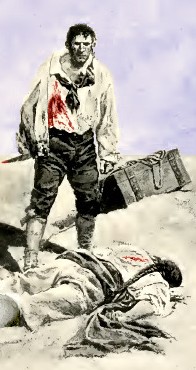
Artist: Howard Pyle
He Lay Silent and Still (1890)
When pirate captain George Lowther took Benjamin Edward's boat the Greyhound, his men "not only rifled the Ship, but whipp'd beat, and cut the Men in a cruel Manner"12. After capturing a Barbadoes-based sloop, Francis Sprigg's men forced "some of the Men to sign their Articles [indicating they had joined the pirate crew], the others they beat and cut in barbarous Manner, because they refused to take on with the Crew"13. Sprigg's men did the same thing to a crew of men hauling a cargo of horses after riding the horses around the deck of a ship and being thrown from them, "telling them [the crew], it was for bringing Horses without Boots and Spurs, for want of which they were not able to ride them."14 During a mutiny, pirate Thomas Winthrop was fighting the mate of a Snow who was resisting capture "and gave him a great cut on the shoulder, by missing his head, where the blow was aimed, and he was thrown into the· sea. He [the mate] swam, notwithstanding"15.
Edward Low's crew liked to cut captured crews.16 In one instance, Low was 'displeased' with a sloop's men, so "he ordered lighted Matches to be ty'd between the Mens Fingers, which burnt all the Flesh off the Bones ; then cut them in several Parts of their Bodies with Knives and Cutlashes; afterwards took all their Provisions a way, and set some of them ashore in an uninhabited Part of the Country."17
Low himself had a particular penchant for cutting off men's ears as a non-lethal form of punishment. When captured ship's Thompson came into Low's presence, he "had his Ears cut off close to his Head, for only proposing to resist Admiral Low's black Flag"18. Another man, Captain Willard, was from "New-England; [and] as Low let none of that Country depart without some Marks of his Rage, cut off this Gentleman's Ears, slit up his Nose, and cut him in several Places of his Body, and, after plundering his Ship, let him pursue his Voyage."19
Perhaps the most graphic account of cutting off ears involved Captain John Welland of the Amsterdam Merchant. When Welland was brought to Low,
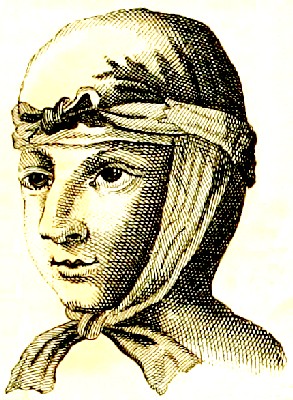
Head Bandage, From A General System of Surgery,
By Lorenz Heister (1750)
he had his right Ear cut off, and was wounded very much with a Cutlass, and turn'd [sent] down the Hatches, where he lay bleeding for two or three Hours with a Centinel over him, at last he asked [pirate] Patrick Cunningham (who he tho't was the means of saving his Life) a Prisoner now at the Bar [Cunningham was on trial] for to get him a Dram, for he was almost spent, and Patrick Cunningham got him some Water; then he [Welland] asked him [Cunningham] for the Doctor, and Cunningham went and brought the Doctor to him, and help'd the Doctor dress him, and said, they were so cruel they could not subsist long.20
This account also brings out the interesting point that even when prisoners were abused, they might still be doctored by the pirate surgeon (in this case, John Kencate). Low got his comeuppance, when one of his men was
cutting at a Prisoner missed his Mark, and Captain Low standing in his Way, very opportunely received the Stroke upon his under Jaw, which laid the Teeth bare; upon this the Surgeon was called, who immediately stitched up the wound, but Low finding fault with the Operation; the Surgeon being tollerably drunk, as it was customary for every Body to be, struck Low such a blow with his Fist, that broke out all the Stitches, and then bid him sew up his Chops himself and be damned, so that Low made a very pitiful Figure for some Time after.21
Low was not alone in his fascination for cutting off ears. Upon hearing that some pirates had been imprisoned on the Brazil coast, pirate captain Edward/Christopher Condent "used all the Portuguese who fell into his hands, who were many, very barbarously, cutting off their ears and noses"22. In the court trial of Bartholomew Robert's men, Harry Glasby deposed that pirate John Stevenson "was for cutting off the chief Mate's Ears" of the Onslow prize they had taken.23 Surgeon Adam Comrie likewise noted that pirate William Fernon told him during a discussion about the owner of a piece of calico from a prize, "that if he spoke a Word more, he would cut his Ears off."24
1 Edward Barlow, Barlow's Journal of his Life at Sea in King's Ships, East and West Indiamen & Other Merchantman From 1659 to 1703, p. 112-3;2 John Moyle, Abstractum Chirurgæ Marinæ, 1686, p. 20; 3 Thanks to the Mercury Crew's Quartermaster William Brand (Pace) for informing my information on sailor's knives. See "The Sailor's Knife Soapbox" post by Mr. Brand, pyracy.com, posted 21 June, 2011, gathered 5/8/16; 4 This was normally the case on naval and merchant vessels; whether pirates kept their weapons locked in a common armory or kept stowed individually when not in use for attacks is not entirely clear from the period accounts; 5 Richard Wiseman, Of Wounds, Severall Chirurgicall Treatises, 1676, p. 362; 6 George Francis Dow and John Henry Edmonds, The Pirates of the New England Coast 1630-1730, 1996, p. 46-7;7 John Wood, "Captain Wood's Voyage Through the Streights of Magellan, &c.", A collection of original voyages (1699), William Hacke, ed., 1993, p. 61; 8 William Dampier, A New Voyage Round the World, 1699, p. 402; 9 Dow and Edmonds, p. 148; 10 Captain Charles Johnson, A general history of the pirates, 3rd Edition, p. 235; 11 The Tryals of Major Stede Bonnet, 1719, p. 23; 12 Johnson, General History, p. 359; 13 Johnson, p. 412; 14 Johnson, General History, p. 416; 15 Captain Charles Johnson, The History of the Pirates, p. 136; 16 See for example Johnson, General History, p. 374; 17 Johnson, General History, p. 380; 18 Johnson, General History, p. 389; 19 Johnson, General History, p. 379-80; 20 "The Tryals of Thirty Six Persons for PIRACY", 1723, From British Piracy in he Golden Age, Vol. 3, Joel Baer, ed., 2007, p. 188-9; 21 Johnson, General History, p. 374; 22 Johnson, History of the Pirates, p. 125; 23 A Full Account of the Tryal Of all the Pyrates Lately taken by Captain OGLE, 1723, p. 52; 24 Pyrates Lately taken by Captain OGLE, p. 46

